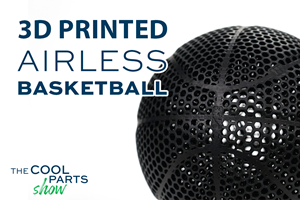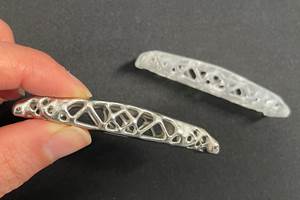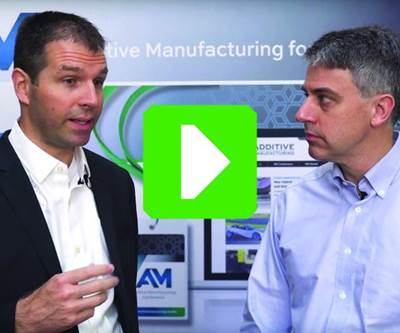Surgical Guides Illustrate Promise of Mass Customization; “Up Front is Where Most Value Created,” Says Materialise’s Vancraen
Interconnected software systems allow for production via additive manufacturing of a product tailored to individual surgeries.
Realizing the full promise of additive manufacturing (AM) will be the result of software innovation every bit as much as the further development of 3D printing hardware. This is particularly true where that promise relates to production of components that are tailored to the individual.
There is nothing new in this insight. However, it was particularly apparent to me during a recent visit to the U.S. headquarters of Materialise in Plymouth, Michigan. The site not only serves users of the Belgium-based company’s AM software products—including Magics for build preparation and Streamatics for AM process management—it also manufactures custom surgical guides within a separate business unit employing a data system developed for this specific use.
Surgical guides tailored to individual patients provide a hard template directing the surgeon precisely where to cut during a procedure such as joint replacement. The surgery can therefore proceed more quickly and accurately, with the patient open on the operating table for a shorter time.
Even though this product is individualized and unique to every person, it is mass produced, and at Materialise I got a glimpse of the interlinking software tools that make this mass customization possible.
A computed tomography (CAT) scan of the patient provides the data sent to Materialise. A proprietary system created by the company to serve this market automatically creates a guide design and surgical plan that is returned to the surgeon for approval. Then, once approved, Streamatics software tracks the part, schedules the build based on capacity and the urgency of the procedure, and maintains the data record a medical component requires. Meanwhile, Magics software ensures efficient 3D printing time by nesting parts made from the same material within a build that puzzles the parts together into the mathematically smallest volume possible. Because the process used to produce the guides is selective laser sintering (SLS), which does not generally require support structures, this nesting can be arranged in three axes. The Plymouth site has five SLS machines, which together provide for a volume of production frequently exceeding 1,000 surgical guides per month, while also making other parts for the company’s prototyping and manufacturing business unit.
“Up front, before the part begins to print, is where most of the value is created,” says Materialise founder Wilfried Vancraen, whom I had a chance to meet during my visit. He sees “verticalization” — creating value within vertical markets by building systems that allow for customization — being a continued way forward for the company. For example, the company also makes individually customized eyewear, 3D printed in a facility in Poland. In serving these verticals, nothing about the 3D printer itself changes — its capability is already sufficient — but instead the promise of the 3D printer opens up because of a system that can transform an individual’s choices or data into mass-customized production. Vancraen says his own company’s size and bandwidth are the limiting factors on serving these verticals, not the availability of potential options. He believes there is so much opportunity in serving patients or consumers with various forms of tailor-made products that “we have to be selective in what we pursue.”
Related Content
8 Cool Parts From RAPID+TCT 2022: The Cool Parts Show #46
AM parts for applications from automotive to aircraft to furniture, in materials including ceramic, foam, metal and copper-coated polymer.
Read MoreAirless Basketball Shows Promise of 3D Printed Lattices: The Cool Parts Show Bonus
Successfully matching the performance of a standard basketball demonstrates the control possible over the mechanical properties of digital materials.
Read MorePossibilities From Electroplating 3D Printed Plastic Parts
Adding layers of nickel or copper to 3D printed polymer can impart desired properties such as electrical conductivity, EMI shielding, abrasion resistance and improved strength — approaching and even exceeding 3D printed metal, according to RePliForm.
Read MoreLarge-Format “Cold” 3D Printing With Polypropylene and Polyethylene
Israeli startup Largix has developed a production solution that can 3D print PP and PE without melting them. Its first test? Custom tanks for chemical storage.
Read MoreRead Next
Video: Smith & Nephew on 3D Printing Patient-Specific Surgical Instruments
Using MRI and additive manufacturing to produce a cutting block customized to the patient aids the precision of the surgery.
Read MoreVideo: Intelligent Layering Metal 3D Printing at 3DEO
Contract manufacturer 3DEO delivers metal parts using Intelligent Layering, a binder jetting-like 3D printing process the company developed and operates internally. Here’s how it works.
Read More3D Printing Brings Sustainability, Accessibility to Glass Manufacturing
Australian startup Maple Glass Printing has developed a process for extruding glass into artwork, lab implements and architectural elements. Along the way, the company has also found more efficient ways of recycling this material.
Read More












.png;maxWidth=300;quality=90)










